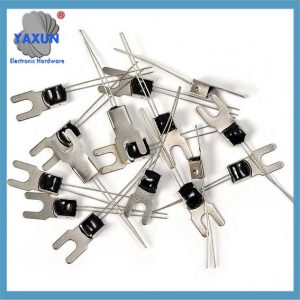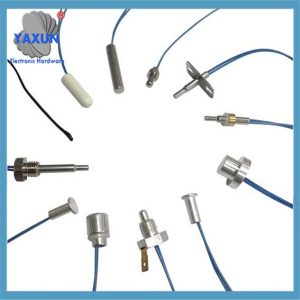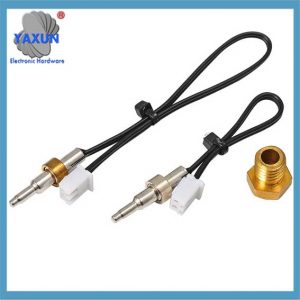在现代工业和汽车电子系统中, 传感器温度传感线束广泛应用于温度监测, 故障诊断和安全系统作为关键传感技术. 传感器探头和测温电缆套件的核心技术涉及温度传感, 信号传输和数据处理. 温度采集专家雅迅采用高精度芝浦NTC热敏电阻用于传感器温度传感线束, 包括传感材料, 信号处理技术, 一体化设计及未来发展趋势.
1. 传感材料
温度传感线束的核心在于其传感材料. 现在, 常用的温度传感材料包括芝浦热敏电阻 (正温度系数/正温度系数), 热电偶和光纤传感器.
芝浦热敏电阻 (正温度系数/正温度系数): NTC电阻值 (负温度系数) 热敏电阻随温度升高而减小. PTC 的情况正好相反 (正温度系数) 热敏电阻. 通过测量电阻的变化, 可准确获取温度信息. 这些材料具有高灵敏度和宽温度测量范围, 但其应用受到环境条件和电阻稳定性的限制.
热电偶: 它由两根不同的金属线组成,通过热电效应产生电压信号. 热电偶温度范围宽、稳定性高, 但它们的信号处理复杂,需要精确的校准和补偿.
光纤传感器: 光纤温度传感技术通过监测光的变化来检测温度. 该传感器具有高灵敏度和抗干扰能力, 适用于恶劣环境下的温度监测.
2. 信号处理技术
传感器温度传感线束的信号处理技术包括两部分: 模拟信号转换和数字信号处理.
模拟信号转换: 传感器输出的信号通常是模拟信号, 需要通过模数转换器将其转换为数字信号 (模数转换器). 模拟信号转换过程中, 噪声抑制等问题, 需要考虑信号放大和滤波,保证信号的准确性和稳定性.
数字信号处理: 数字信号处理技术可以对传感器输出的数字信号进行进一步分析和处理. 例如, 使用算法进行温度补偿, 纠错和数据平滑. 现代温度传感线束通常集成微处理器或微控制器,通过软件实现复杂的信号处理和数据分析功能.
3. 一体化设计
温度传感线束的集成设计涉及传感器的综合考虑, 信号处理单元, 和连接线束.
传感器集成: 将传感器模块嵌入线束中可以实现节省空间和紧凑的系统设计. 传感器的布局需要考虑温度测量的精度和响应速度, 同时保证线束的机械强度和耐用性.
信号传输: 在信号传输方面, 需要选择合适的电线和连接器,以减少信号衰减和干扰. 优质屏蔽和绝缘材料,提高信号传输的稳定性.
系统集成: 现代温度传感线束通常需要与其他电子系统集成, 包括通讯接口, 数据存储, 和处理单元. 系统集成设计需要考虑兼容性, 可靠性, 和可扩展性,满足不同应用场景的需求.
4. 未来发展趋势
随着科学技术的进步, 温度传感线束技术也在发展. 未来趋势包括:
智力: 温度传感线束将逐步向智能化发展, 并实现自我诊断, 自适应调整, 通过集成更多传感器和处理单元实现远程监控功能.
小型化: 随着电子元件的小型化, 温度传感线束的尺寸将变得越来越小, 适合更紧凑、更复杂的应用场景.
高可靠性: 未来的温度传感线束将更加注重可靠性和耐用性,以满足恶劣环境下的应用要求, 比如高温, 高湿度和强振动环境.
多功能性: 除传统的测温功能外, 未来的温度传感线束可能会集成更多功能. 例如, 湿度检测, 压力测量, ETC。, 提供更全面的环境监测能力.
5. 结论
作为重要的传感技术, 芝浦NTC热敏电阻温度传感线束的核心技术包括传感材料, 信号处理技术与集成设计. 随着科学技术的发展, 温度传感线束将向智能化方向发展, 小型化、多功能化,满足更复杂的应用需求. 通过不断的技术创新, 温度传感线束将在工业中发挥越来越重要的作用, 汽车电子等领域.
功能特点
芝浦热敏电阻元件:
由于采用玻璃封装, 与树脂封装热敏电阻相比, 具有优异的耐热性和耐候性,使用寿命更长.
由于引线通过金电极粘合到热敏电阻芯片上, 特性稳定 (PSB-S, NS, PL型热敏电阻元件).
特征
金属焊接电极结构
由于镀锡金属电极,镀锡效果极佳
由于采用玻璃封装,因此具有优异的耐热性和耐候性
组装过程中具有出色的耐焊接耐热性
由于使用的是方形玻璃, 实际组装时不会出现移位、脱落等固定不良现象
应用实例
适用于以下SMT对应的温度测量应用 (表面贴装);
与通用芯片热敏电阻相比,需要更高可靠性的应用;
工业电机预防过热;
IGBT的温度补偿 (绝缘栅极晶体管) 设备;
SMT的一般电子零件的温度补偿 (表面贴装);
工作温度范围-50+200℃;
热时间常数大约 10 秒;
耗散常数约1.4W/℃;
焊料耐热350℃ 3 秒;
※除非另有说明, 热时间常数和耗散常数是测试结果.
 English
English العربية
العربية Български
Български 粤语
粤语 中文(简体)
中文(简体) 中文(漢字)
中文(漢字) Nederlands
Nederlands Suomi
Suomi Français
Français Deutsch
Deutsch Ελληνικά
Ελληνικά Magyar
Magyar Italiano
Italiano 日本語
日本語 한국어
한국어 Polski
Polski Português
Português Română
Română Русский
Русский Slovenščina
Slovenščina Español
Español Svenska
Svenska ภาษาไทย
ภาษาไทย Türkçe
Türkçe Tiếng Việt
Tiếng Việt



